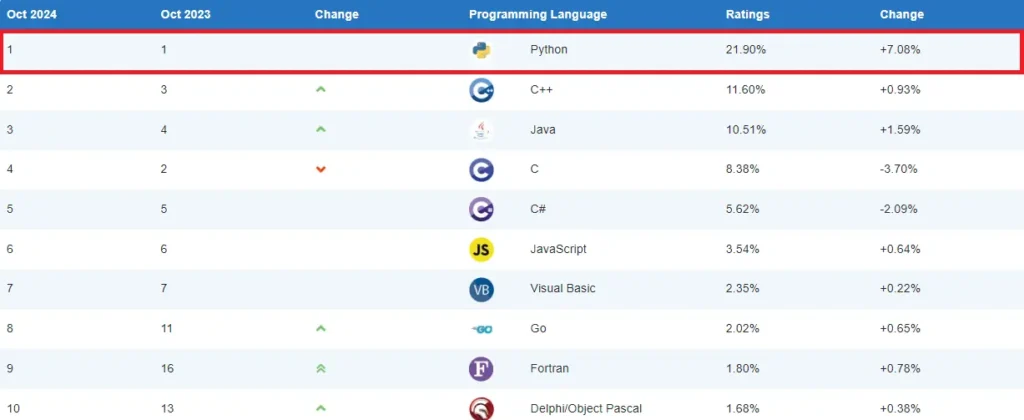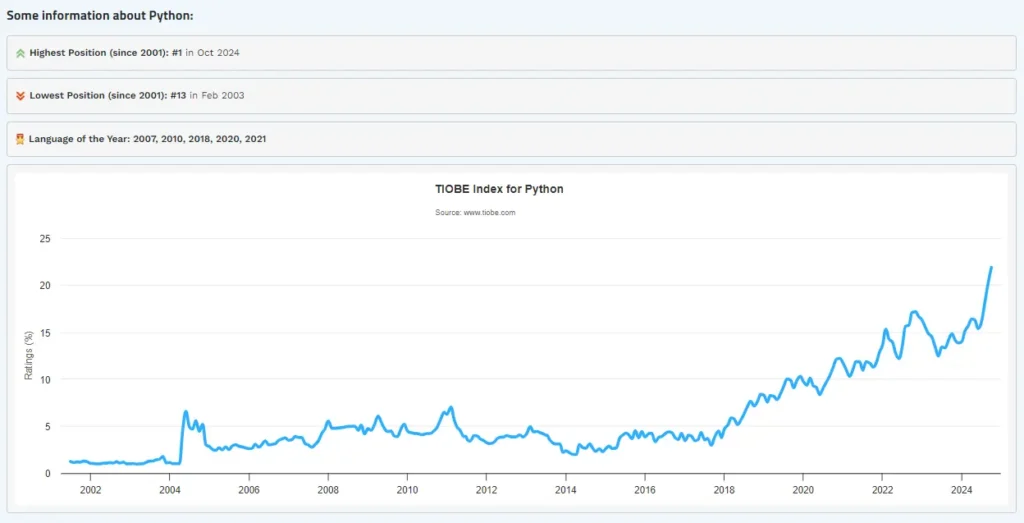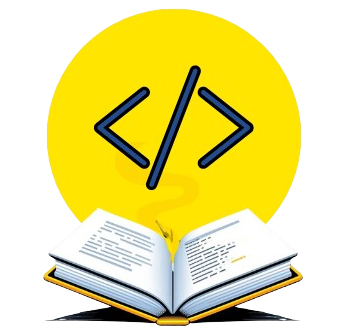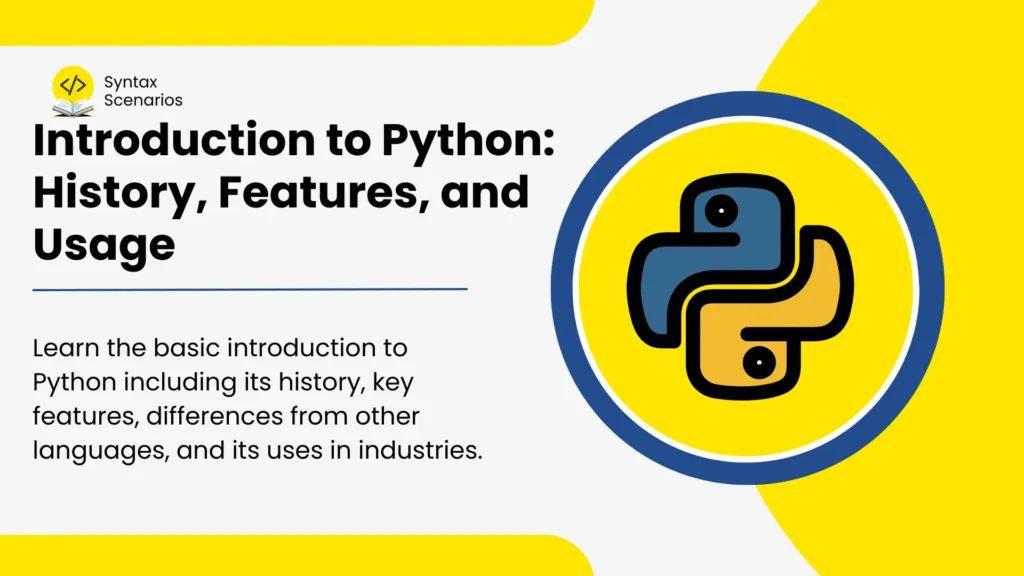In this guide, you will learn the basic introduction to Python including its history, key features, differences from other languages, and its usage in industries.
Table of Contents
Python is a powerful, general-purpose, high-level programming language introduced by Dutch programmer Guido van Rossum in 1991. During the creation of Python, the main focus was on code readability and simplicity. Python provides valuable tools and features that help both beginner and experienced programmers in many aspects.
The Story – How Python was Named as Python
In the early 1980s, Guido van Rossum was developing this new programming language at the Centrum Wiskunde & Informatica (CWI) in the Netherlands. He wanted to give a brief, unique, and mysterious name to his language because he wanted to keep it different from other serious, typical, and technical names that most programming languages have. Guido was a fan of the British comedy series “Monty Python’s Flying Circus” which aired in the 1960s. He enjoyed the humor and decided to name his language “Python” inspired by the show. Like van Rossum’s goal of making programming pleasant, the word “Python” brings up an instant feeling of playfulness and fun activity.
Key Features of Python
The following are some of the main characteristics that lead to its broad use, adoption, and popular choice for developers:
Simplicity and Readability
Using Python, developers can write logical concepts in just fewer lines of code as compared to Java, C, or C++ making it simpler. Also, because of its similarity with the English language, it is easier to understand the code by just looking at it.
Interpreted Language
Python is an interpreted language, which means that its code is executed line by line, rather than being compiled all at once into machine code. This allows for easier debugging and more flexibility during development.
A real-world analogy for an interpreted language is a live interpreter translating a speech in real-time. Just as the interpreter listens to each sentence and immediately translates it into another language for the audience,
Platform Independent
The interpreted nature of Python makes it platform-independent. This means you can run Python programs on different operating systems like Windows, macOS, and Linux without changing the code. This feature allows developers to write their code once and run it anywhere, making it highly convenient and versatile for various applications.
Imagine the nature of Python as an adaptive travel guide that adapts to various environments and cultural norms, guaranteeing a smooth trip wherever you go.
Wide-Ranging Libraries
Python offers a wide variety of packages and modules with pre-written code so the developers don’t have to write everything from scratch, helping them to save their time.
Python’s large library is like having a workshop full of many different tools. It’s like a craftsman having everything from basic hammers to special saws and paints.
Dynamically Typed Language
While coding in Python, you do not have to declare the data types for variables whether it is an integer, float, string, or whatever. Python’s interpreter automatically determines the data type at run time. It simplifies coding and reduces complexity.
Think of dynamic typing in Python as a reusable shopping bag. You can use this bag to carry groceries one day, books the next, and clothes another time. The bag doesn’t need to know in advance what it will carry. It simply adapts to whatever you put in it. Similarly, in Python, a variable can store any type of data at different times, adjusting to what you assign to it without needing to declare a specific type beforehand.
Python Popularity Statistics for 2024
According to the TIOBE Index for October 2024, Python holds the top position with a rating of 21.90%, which reflects a significant growth of 7.08% compared to the same time last year.

In October 2024, Python reached its highest position ever in the TIOBE Index, securing the #1 spot with a rating of 21.90%. This marks a significant achievement since its lowest position was #13 in February 2003. Over the years, Python has consistently gained popularity, being named “Language of the Year” multiple times, including in 2007, 2010, 2018, 2020, and 2021. The graph highlights Python’s growth over time, showing a steady rise since around 2018, reaching its peak in 2024.

How is Python different from other languages?
Here are some key features that make Python different from other programming languages
| Aspect | Python | Other Languages (e.g. Java, C++) |
| Code Structure | It uses indentation for code structuring. | Braces are used for the structuring of code. |
| Typing System | Dynamically typed i.e. no need to declare data types. | Statically typed i.e variable data type has to be explicitly declared. |
| Platform Independence (Portability) | Highly portable. | Java is portable, whereas C++ is less portable (OS-dependent). |
| Code Conciseness | Allow you to achieve more with fewer lines of code. | Often requires more lines of code to achieve the same tasks. |
| Programming Paradigm | Flexible, allows both procedural and object-oriented styles. | C++ supports both procedural and object-oriented, while Java is object-oriented. |
| Execution Method | Both compiled and interpreted. | Compiled to machine code (C++) or bytecode (Java). |
Practical Usage of Python in Industries
Python is widely utilized in a wide range of sectors and businesses because of its adaptability, simplicity of learning, and robust library. Here are a few real-world uses for Python:
Machine learning
Python is the preferred language for machine learning. Because it provides strong tools and libraries like NumPy, Sci-kit learn, Pandas, and much more that makes the data manipulation and preprocessing easier. Also, Python is the industry leader in machine learning due to its strong community support that guarantees assistance to developers, and ongoing innovation.
Web Development
Developers often opt for Python frameworks such as Django and Flask on the backend. These modules allow for data processing, database access, URL routing, content management, and server data sharing.
Google, Facebook, Instagram, YouTube, Dropbox, and Reddit are some of the well-known websites and apps built mainly with Python.
Game development
Game developers use Python mainly because it is easy to use and has robust libraries. One of the most well-known libraries is Pygame, which simplifies the creation of 2D games. Pygame includes key features for controlling game events, processing input, and generating images. Python’s ease of use and readability allow developers to quickly prototype and refine game concepts. Additionally, developers often use Python for scripting in larger game engines like Unity to automate time-consuming tasks and manage game logic.
Conclusion
Python provides an easy-to-use, powerful, and flexible framework for all programmers, from beginners to experts. Its large libraries and support for various programming styles make it great for experienced developers, while its simple syntax and readability are perfect for newcomers. Python is essential in today’s tech world because it can be used for many things, like web development and data analysis.
Now that you got an idea about Python, let’s dive into it further. Check out variables and data types in Python.
FAQs
What is Python and who created it?
Python is a general-purpose, high-level programming language developed by Guido van Rossum in 1991. It focuses on simplicity and readability that makes it a popular among both beginner and expert programmers.
How did Python get its name?
Python was named after the British comedy show “Monty Python’s Flying Circus,” which its creator Guido van Rossum enjoyed. He wanted a unique and playful name that was different from typical programming language names.
What makes Python different from other programming languages?
Python uses indentation for code structure, is dynamically typed, and is highly portable. It allows both procedural and object-oriented programming styles, and due to its concise syntax, developers can write fewer lines of code compared to languages like Java or C++.
How popular is Python in 2024?
As of October 2024, Python holds the top position in the TIOBE Index with a rating of 21.90%. It has been recognized as the “Language of the Year” multiple times and continues to be widely adopted.
Where is Python used in the industry?
Python is used in various industries for machine learning, web development, and game development. Its extensive libraries and frameworks, such as Django, Flask, and Pygame, make it a versatile tool for creating everything from websites to machine learning models and games.

